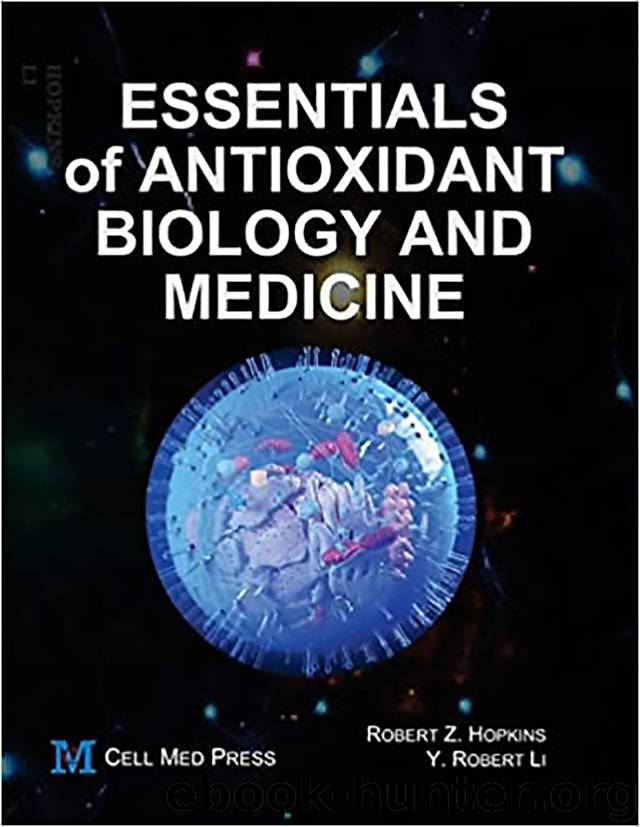ESSENTIALS OF ANTIOXIDANT BIOLOGY AND MEDICINE by Unknown

Author:Unknown
Language: eng
Format: epub
Published: 0101-01-01T00:00:00+00:00
UNIT IV
The thioredoxin system
Chapter 11. Thioredoxin
HIGHLIGHTS
§ Thioredoxin (Trx) refers to a class of small redox proteins that undergo NADPH-dependent reduction by thioredoxin reductase (TrxR) and in turn reduce the disulfide bridge in target proteins. Mammalian Trxs include two isozymes, namely, Trx1 and Trx2.
§ In addition to directly scavenging reactive oxygen species (ROS), Trxs serve as cofactors for various enzymes, including ribonucleotide reductase, peroxiredoxins, and glutathione peroxidase 3. Trxs also modulate the activity of many transcription factors.
§ Studies in animal models have shown that both Trx1 and Trx2 protect against disease conditions that involve oxidative and inflammatory stress, especially cardiovascular disorders. On the other hand, Trxs may promote cancer development under certain conditions.
§ The exact role of Trxs in human health and disease remains largely unknown.
keywords | DNA synthesis; Molecular regulation; Nuclear factor E2-related factor 2; Oxidative stress; Protein denitrosylation; Redox protein; Redox signaling; Ribonucleotide reductase; Thioredoxin; Tumorigenesis
CITATION | Hopkins RZ and Li YR. Essentials of Antioxidant Biology and Medicine. Cell Med Press, Raleigh, NC, USA. 2020. http://dx.doi.org/10.20455/eabm.2020
ABBREVIATIONS | ARE, antioxidant response element; ASK1, apoptosis signal-regulating kinase 1; GPx3, glutathione peroxidase 3; mTOR, mechanistic target of rapamycin; Nrf2, nuclear factor E2-related factor 2; ROS, reactive oxygen species; Trx, thioredoxin; TrxR, thioredoxin reductase; Txnip, thioredoxin-interacting protein
CONTENTS
1. Overview
2. History
3. Biochemistry
4. Molecular Regulation
4.1. Nrf2 Signaling
4.2. Other Regulatory Mechanisms
5. Biology and Medicine
5.1. Antioxidant Functions
5.1.1. Mechanisms of Antioxidative Effects
5.1.2. Role of Trx1 in Protecting against Oxidative Disease Processes
5.1.3. Role of Trx2 in Protecting against Oxidative Disease Processes
5.2. Role in Embryonic Development
5.3. Role in Cell Signaling
5.4. Role in Cancer Development
6. Conclusion and Perspective
7. Self-Assessment Questions
1. OVERVIEW
The term thioredoxin (Trx) refers to a class of small redox proteins (~12 kDa) that undergo NADPH-dependent reduction by thioredoxin reductase (TrxR; see Chapter 13 on TrxR) and in turn reduce the disulfide bridge in target proteins. Currently, there are two Trxs in mammals: Trx1 and Trx2. They are ubiquitously distributed in mammalian tissues. Trx1 is predominantly located in the cytosol and can be also excreted into the extracellular space or translocate into the nucleus, whereas Trx2 is present in the mitochondrion. In humans, Trx1 and Trx2 are localized on chromosomes 9q13 and 22q13.1, respectively. Table 11.1 summarizes the basic characteristics of mammalian Trxs. It should be noted that the term ‘thioredoxin superfamily’ is often encountered in the literature and refers to a large group of proteins, including Trxs, glutaredoxins (see Chapter 10 ), and protein disulfide isomerases (PDIs).
Download
This site does not store any files on its server. We only index and link to content provided by other sites. Please contact the content providers to delete copyright contents if any and email us, we'll remove relevant links or contents immediately.
| Automotive | Engineering |
| Transportation |
Whiskies Galore by Ian Buxton(41529)
Introduction to Aircraft Design (Cambridge Aerospace Series) by John P. Fielding(32888)
Small Unmanned Fixed-wing Aircraft Design by Andrew J. Keane Andras Sobester James P. Scanlan & András Sóbester & James P. Scanlan(32573)
Craft Beer for the Homebrewer by Michael Agnew(17933)
Turbulence by E. J. Noyes(7700)
The Complete Stick Figure Physics Tutorials by Allen Sarah(7138)
Kaplan MCAT General Chemistry Review by Kaplan(6595)
The Thirst by Nesbo Jo(6436)
Bad Blood by John Carreyrou(6274)
Modelling of Convective Heat and Mass Transfer in Rotating Flows by Igor V. Shevchuk(6222)
Learning SQL by Alan Beaulieu(6035)
Weapons of Math Destruction by Cathy O'Neil(5829)
Man-made Catastrophes and Risk Information Concealment by Dmitry Chernov & Didier Sornette(5646)
Digital Minimalism by Cal Newport;(5389)
Life 3.0: Being Human in the Age of Artificial Intelligence by Tegmark Max(5184)
iGen by Jean M. Twenge(5161)
Secrets of Antigravity Propulsion: Tesla, UFOs, and Classified Aerospace Technology by Ph.D. Paul A. Laviolette(4990)
Design of Trajectory Optimization Approach for Space Maneuver Vehicle Skip Entry Problems by Runqi Chai & Al Savvaris & Antonios Tsourdos & Senchun Chai(4839)
Electronic Devices & Circuits by Jacob Millman & Christos C. Halkias(4748)
